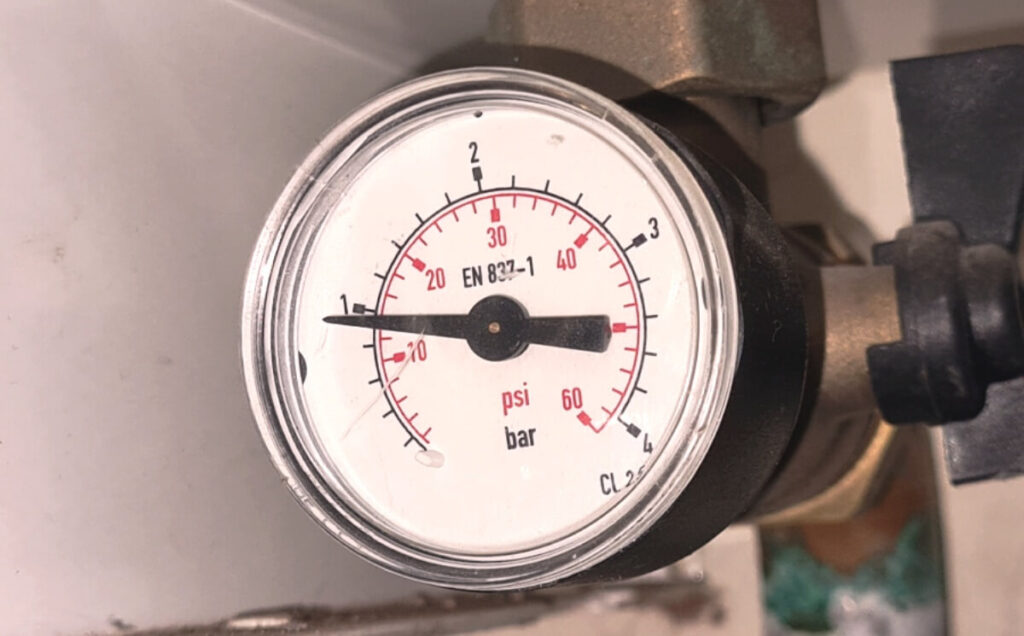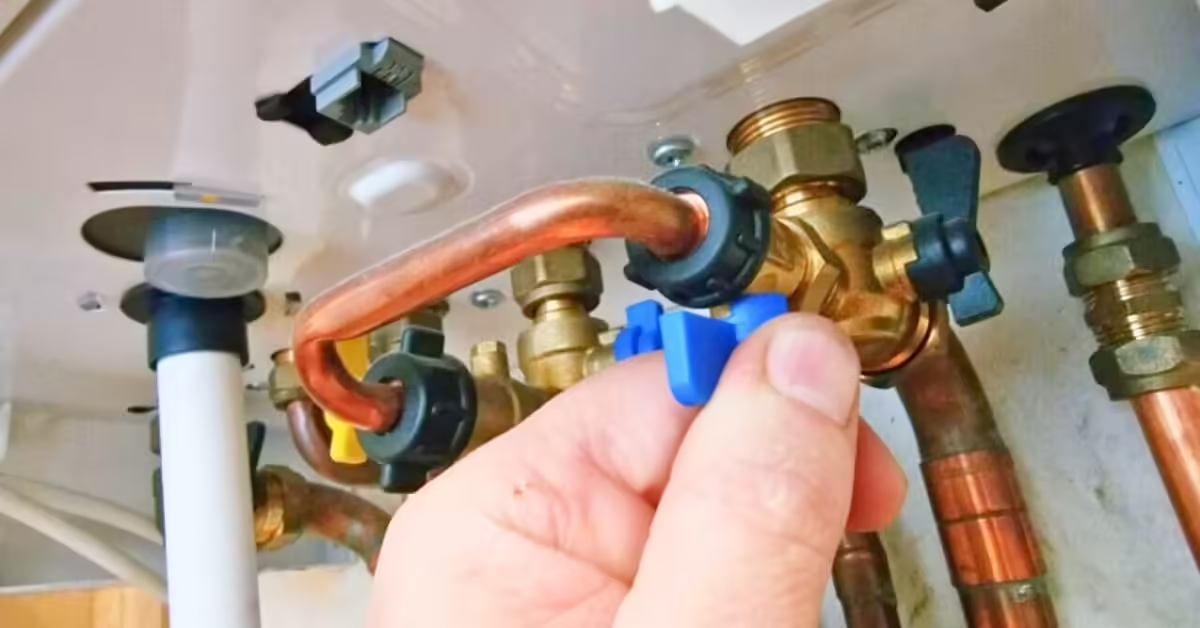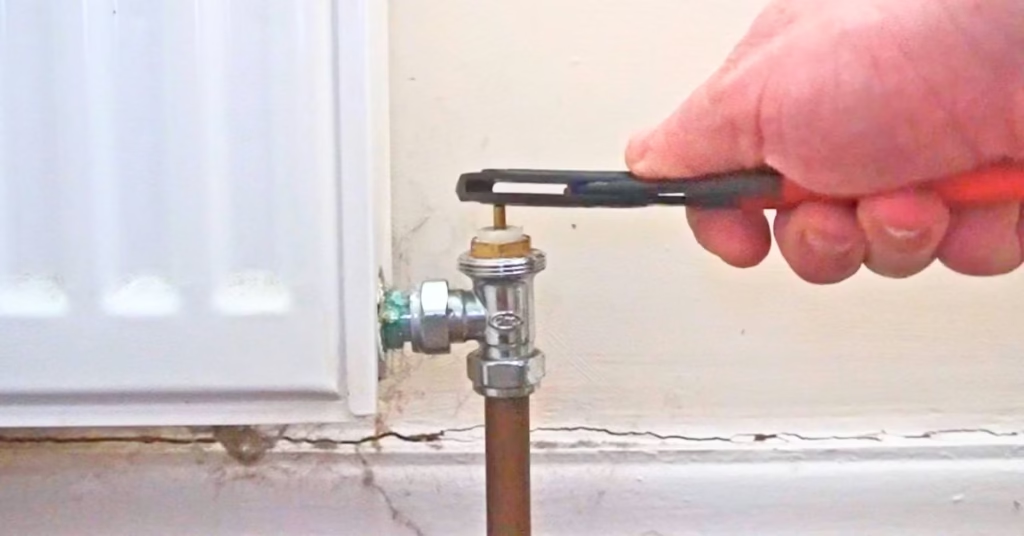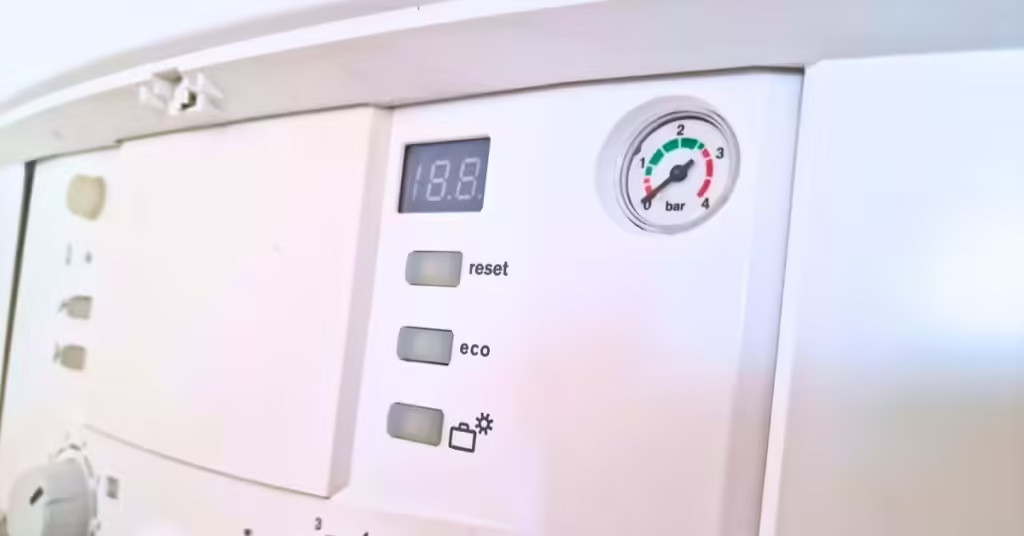Last updated on March 2nd, 2025
When your pressure drops too low, the boiler will stop working, which means no heating or hot water. The pressure should be between 1 and 1.5 bar when the radiators are cold. I have been repairing and servicing boilers for over a decade and have fixed many boiler pressure problems.
Ideal boiler pressure explained
Ideal boilers have a safety device called a pressure relief valve (PRV). If the pressure reaches 3 bar the PRV will open and the water will be let out as a safety precaution, the pressure gauge will drop to zero.
If your pressure is under 1 bar, you should increase it. If it’s over 1.5 bar when the heating is off and the radiators are cold, you should reduce it. The boiler pressure can rise to over 2 bar when the heating is on. This is perfectly normal as the heat expands the water inside the radiators when the heating is turned on.

Boiler pressure too low
Low boiler pressure is very common and can cause your boiler to stop working. If your Ideal boiler pressure becomes too low you might get the F1 error which means you need to repressurise it. If the pressure drops below 1 bar you should increase it.
How to increase the pressure:
- Open one valve fully
- Open the other valve slowly until you can hear the water
- When the pressure has reached 1 to 1.5 bar close both valves
- Reset the boiler (if needed)
- Turn the heating on
Do not open both filling loop valves fully straight away as the water pressure in the house might be too much for the boiler and cause the pressure to shoot up too high.
How often should you need to repressurise a boiler?
You shouldn’t need to repressurise your boiler at all. A pressurised heating system is sealed so if you need to increase the pressure regularly then the water is getting out. If you have to repressurise once or twice a year I wouldn’t worry about it.
Boiler pressure too high
There are many reasons for a boiler’s pressure to be too high. If the pressure reaches 3 bar the PRV will let the water out. So, if your pressure is above 1.5 bar when the heating is and the radiators are cold, you should reduce it. To reduce the pressure you must let some water (or air) out of the heating system.
How to reduce boiler pressure:
- Bleed a radiator
- Open a drain off valve
- Open the pressure relief valve
- Crack a nut
- Magnetic filter
The first thing you should do to reduce the pressure is bleed the air out of every radiator. There might not be any but if there is, removing it will drop the pressure. Bleeding water out of one radiator is the easiest way to reduce boiler pressure but also the slowest.
Boiler keeps losing pressure
A boiler that keeps losing pressure means there’s a problem that needs to be fixed.
Most common reasons:
- A Leak on the central heating system
- The expansion vessel has lost its air
- Pressure relief valve passing water
- Filling loop open
You should check if the pressure is rising to 3 bar when the heating is on to narrow down the problem. If the pressure is dropping to zero without rising too high first, you most likely have a leak somewhere on the system.
More Ideal boiler guides
Summary
If your boiler pressure is too low or too high, fixing it is important. Repressurising an Ideal boiler is an easy job. It can save you from paying a plumber to do an easy task.
If you have to keep repressurising your boiler, you should get that problem found and fixed as soon as possible.
Have any questions? Drop them in the comments below, I’ll do my best to help! If you found this post helpful, don’t forget to share it with others who might benefit.





Ideal logic monobloc ASHP and new radiators fitted in all rooms in March 2023 Electric only..no gas in our area.
Pressure usually sits at around 0.8b. Have increased pressure by topping up about 3 times since installation. For last 3 months pressure drops to around 0.4bar ( sometimes lower) overnight when heating turned down then rises to 2 when heating comes on again in morning.
Ideal suggested I had boiler serviced even though under guarantee and have not returned my calls in last 3 weeks.
Have checked all round radiators and ASH pump..no leaks found. No fault indicated on halo or on boiler display.
I am away from home for a week soon and worried about the impact the low boiler pressure will have because of course the system will be set on lower temps (usually leave it on 15° when away from home) for that week.
Any suggestions please? Thanks
There could be a leak on a pipe under the floor or the pressure relief valve might be letting water out. More info here https://housewarm.co.uk/blog/heating/boiler-keeps-losing-pressure/
Thanks for that Steven will have a read of that info.
Great advice, but my boiler only has two black taps and a yellow gas tap. i’ve tried to open both the black taps but the pressure doesn’t move and i can’t hear the water moving. i have the Ideal logic system s30.
Hi Andrew, the filling loop will be elsewhere on a system boiler as there’s no water supply at the boiler. It’s usually in the hot water cylinder cupboard.
Your article is spot on. We had a problem with topping up the system every day but that was solved when I replaced some pvc pipework in the loft.
However, I now have a different problem. When we get a F1 fault and the gauge is at zero. If we top it up (the way you suggest) if we crack the closed loop value just a tiny bit, I mean a tiny bit, the pressure shoots right up.
What do you think ?
Hi Brian,
Sounds like the expansion vessel has no air in it. It might need to be recharged or possibly replaced.
More info here https://housewarm.co.uk/blog/heating/recharge-expansion-vessel/
It could also be the small hose inside the the boiler which connects the expansion vessel to the heating system, this can get blocked on dirty heating systems and is a nightmare to replace as you have to strip half the boiler down.
I would rule out the expansion vessel first though.